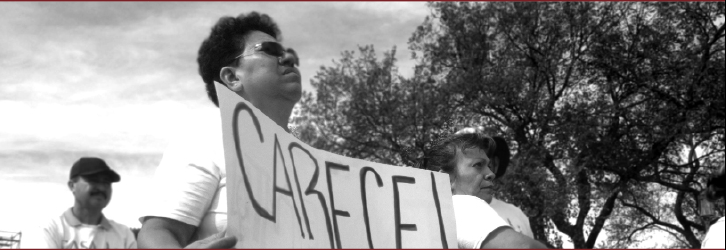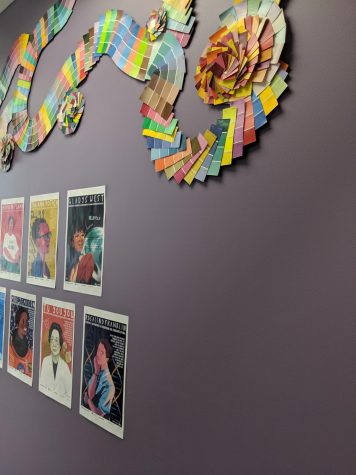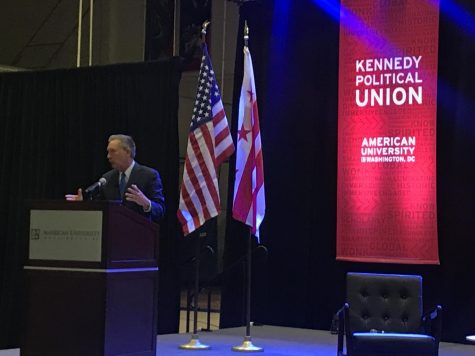One Woman’s Struggle with Life and Loss in the Immigration Debate Like the Eagle in Flight
“I KEPT GOING”
It was the middle of the night when she left San Salvador, that stained Salvadoran city she called home. Daysi Perla watched the fading lights of the Parque Libertad, site of the Massacre of 1977. The images of soldiers descending on the crowd would never leave her. The cries of women and children at the foot of the El Rosario Church begging to be let in by the friars would stay with her always.
As the bus trundled on through the dust-caked road, making its way north into Mexico, Perla thought of her son. Francisco Perla was eight years old in 1990, the year his mother left for the United States. Born two years after the Salvadoran Civil War broke out, he learned about the world through the lens of violence and danger. She would not let him come with her. He was sent to live with his grandmother in La Union.
“I never wanted to put my child in danger,” Perla says. “I didn’t want to show him any of this.”
Perla arrived in Mexico City days later. Hawkers and peddlers swarmed the streets. She soon found that unlike Hondurans or Guatemalans, she and other Salvadorans could pass for Mexicans from Veracruz due to their similar accents, called “jaracho.”
But her luck didn’t last. Just moments before she was to board her bus to the border, a man approached her at a public telephone, shouting indiscernible questions. She waved him off, and he left. When she looked down at her hand, Perla realized the bus ticket she had been holding was gone.
It was May in Mexico City, and the sun beat down in the Federal District, by far the biggest city she had seen. She was alone.
Her trip would get more arduous but she found inspiration elsewhere.
“I have faith in God and in good people,” Perla said. “And I met someone who told me I could stay in their house. They gave me a bed. They gave me food. I worked there for a little while, and afterwards, I kept going.”
Eventually she found herself on a different bus, but her destination was the same: the United States. When the bus finally stopped, a man toward the front ordered everyone out and told them to run. She can’t recall the images from that night, or even when she crossed the border, just the heavy falling of breath in the desert night. Somewhere in south Texas, they reached a bus station.
…
In the center conference room of the Central American Resource Center of Washington, DC, a Columbia Heights nonprofit, Perla wears the years with a quiet smile. Before her sits a stack of fliers and a call list. Perla began volunteering for CARECEN shortly after arriving in the city in the early 1990s. For the past few days in October she’s been rallying the local community for the immigration reform march set to take place the following week on the National Mall. But by the fourth day of the government shutdown, the event’s organizers are on high alert. Around the country, news agencies are breaking stories about closed monuments and the wrath of visitors. The Mall is a ghost town.
…
Three months after emigrating, in September 1990, she found a job as a nanny for a well-to-do Chevy Chase family. The pregnant wife was due before the end of the year and needed help that her working husband couldn’t provide. Perla stayed with the family for eight years, through the birth of another baby girl and the children’s days in elementary school. She cooked for them and bathed them, even taught them Spanish.

“I took care of them like they were my children,” she remembers.
But they weren’t hers. Her child came to her once a month, materialized on a post-card with the pencil scratchings of a young boy, or a distant voice crackling through the phone. She remembers the ache:
“It was really hard when I couldn’t come, and he would tell me, ‘Mommy, it’s Christmas and you’re not with me. Mommy, it’s Mother’s Day and you’re not with me. Mommy, I don’t remember what you look like.’”
Years after arriving, she risked everything and returned to El Salvador to tend to her sick mother in La Union, the fishing port city where her family lived. But what she thought would be an emotional homecoming, a filial reunion, ended in a bitter realization. Francisco now stood at equal height with Daysi. His frame was bigger than that of the small child she had cradled under her bed when government forces besieged San Salvador for three days, and she had to shield him from stray bullets. Now, he wouldn’t meet her eyes. He resisted her touch, the 2,000 miles still present even as she stood within arms length of him. Perla flew back to Washington, wrought with grief.
“I’m paying a very big price to be here,” she told herself in the days after her return. “I’m losing my child.”
***
By 1998, it was time to leave the family that employed her. The girls were older and no longer needed her. But again, she felt the pang of departure, of leaving.
“It wasn’t the way I wanted it to be, but it was necessary. I spoke with the oldest and asked for her forgiveness. Their entire lives were with me, and all of a sudden I wasn’t there,” she said.
After bouncing around jobs in the kitchens of different Washington businesses, Perla graduated from Carlos Rosario charter school with a certification in culinary arts. She went to work for Teen Bridges, a program of the Latin American Youth Center, where she remains today, teaching basic life skills such as cooking and grocery shopping to underprivileged and formerly abused adolescents of the District’s child welfare agency. But she still volunteers for CARECEN when she finds the time.
A DREAM DEFERRED
In April of this year, not far from Perla’s 14th Street apartment, a group of senators gathered on Capitol Hill to “hash out” a solution to the crisis of 11.7 million undocumented immigrants and backlogged visa queues. The so-called “Gang of Eight” drafted an immigration reform act that would grant those 11 million the opportunity, or “pathway” to American citizenship.
Marcy Campos, the director of the Center for Community Engagement and Service at American University, and professor of a course called “The Latino Community of the DC Metropolitan Area,” described the recent hubbub surrounding the debate.
“It’s the timing; it’s the demographics; it’s Obama, and it’s also all the organizations that are playing an active role in organizing,” Campos says. “There’s a lot more unity, there’s a lot more activism.”
The Border Security, Economic Opportunity, and Immigration Modernization Act would make nearly impossible the 1990 trip Perla took across the border. The Act calls for the installation of 350 new miles of fencing, armed security personnel and new towers—all at a $46 billion price tag. But it would also bring the immigration quotas for visas up to date and do away with the cap on numbers from certain countries like El Salvador.
To the dismay of millions, the bill is languishing in the House of Representatives, where the once fiery debate for reform has been sequestered by a swath of political issues, from the use of chemical weapons in Syria to, most recently, the shutdown of the federal government.
Campos, who says that back in the spring she couldn’t go a day without reading about the debate, says the once-bubbling media attention has fizzled.
“A lot of things have happened in between then, and it’s slowed down a lot,” she says.
Kristen Williamson, a spokeswoman for the Federation of American Immigration Reform, a political non-profit organization, opposes the bill. She said giving a pathway to citizenship to the country’s nearly 12 million undocumented residents would be giving amnesty to criminal behavior.
“At a time when our country is facing unemployment and underemployment, we think that Congressmen and women should be focusing on Americans and not illegal and legal immigrants,” Williamson says.
Williamson supports systemic reform, but her suggestion for change is a different beast. Even though President Obama set a record when he deported 1.5 million undocumented immigrants in his first term, Williamson still decries what she considers the failure of “interior enforcement.”
She supports the increase of programs like Secure Communities that mandate the collaboration of local and federal law enforcement agencies with Immigration and Customs Enforcement, the deportation enforcement agency of the Department of Homeland Security. Williamson said FAIR would also like to see a nationwide implementation of the E-Verify program, which is designed to weed out undocumented immigrants from the workplace.
Williamson said that visas and other legal avenues for immigrants should be reduced as well. Once the incoming numbers are lowered, she said that sending people back to their countries after their statuses expire is the next step. She suggests “biometrics:” a strategy embraced by various House Republicans that calls for fingerprinting and database indexing to track all legal newcomers to the country.
“The most important aspect of entry-exit is the exit portion,” she says.
WAITING ON WASHINGTON
Perla believes that in some ways, it is her duty to rally support for the upcoming march.
“I think it’s important that while the Congressmen are fighting, the Latin American community takes to the streets, so that they know we are here and we aren’t leaving,” she explains.
She also has personal impetus for wanting change on the immigration front: she’s waited for Francisco for 23 years.
In 1990, Perla applied for Temporary Protected Status, a new provision of the Immigration and Nationality Act that guaranteed amnesty for immigrants hailing from war-torn and disaster-struck regions. When Temporary Protected Status ended for Salvadorans in 1992 during the Clinton administration, so did her son’s hope for residency. Grandfathered into the system, Perla was granted asylum in 1996 under the Nicaraguan Adjustment and Central American Relief Act. By the time she finally got her green card in 2003, her son was no longer a minor, and thus a low priority for the US Citizenship and Immigration Services.
While the Congressmen are fighting, the Latin American community takes to the streets so they know we are here.
“I’m still waiting to find out if my son will get his residency status… He has always been waiting, to come legally,’’ she says. “He has never wanted to come the way the majority of them come to this country. He never wanted that.”
A PRICE TOO HIGH
Though safeguarding American jobs for Americans is an imperative, all too often tax-paying workers are estranged from their families as a result of dated policy.
After he turned 21, Francisco Perla idled in the backwaters of the immigration pool. Now 31, his best chance at coming to the United States is through employer-based preference, a tightly bound system where supply at the current quota rate has no chance, nor intention, of meeting demand.
The US quota for H1 visas, or visas for high skilled workers, capped out after five days last fiscal year. H2B visas, for which Francisco is eligible, have had similar outcomes in four of the last ten years. But the nonagricultural workers covered by H2B visas face an interesting challenge. Not only must an American employer sponsor them, but the sponsor must also prove that “there are not enough U.S. workers who are able, willing, qualified, and available to do the temporary work.” Fewer than 4,000 applications were certified in 2012.
The years have taken their toll on Perla and her son. Francisco, now a husband, father and ornithologist for a reforesting organization, has put immigrating to the U.S on the back burner.
“He’s not going to come stay. He’s coming to get his residency and leave,” Perla says, her voice weary.
“I know that I have a very fragile relationship with my son,” she adds sadly. “I failed being with him, seeing him grow… This is the price I’ve paid. He doesn’t know me and I don’t know him.”
A MARCH IN OCTOBER
Tuesday, Oct. 8: the day of the immigration march. Earlier that week, the Obama administration had announced it would open the occasion. Perla takes the 11:15 a.m. bus to 12th street and Independence Avenue. She walks past rows of American elm trees, past bearded men wielding signs equating immigrants with sin and toward a collage of flags, colors and smiling faces. In the otherwise quiet morning on the National Mall, chants swell in Spanish and English, breaking the morning air.
In her CARECEN shirt, she scans the crowd. All around her are the logos and signs of organizations. But the CARECEN shirts distributed one week before are nowhere to be found. The clock strikes noon and Nancy Pelosi takes the stage, a miniscule figure under the “Camino Americano” banner.
“The blood of immigrants runs through all our veins,” Pelosi shouts into the microphone, stoking cheers and whistles from the crowd.
Perla makes her way past TV reporters and cameramen, toward the left side of the stage. Still, no one.
But then, just as Pelosi descends in time for a photo-op, and as the host announces the next band, she spots them: a small group of white shirts with bright orange letters behind the jumbotron. There in the middle, a sign reads “CARECEN.” She sees the smiling faces of the center’s staffers, volunteers, and community members. As the Mexican band, Los Tigres del Norte, bellow their famous ballad “De Paisano a Paisano,” she joins them.
Como el águila en vuelo
Como la fiera en celo
Desafiando fronteras
Defendiendo el honor
He pasado la vida
Explorando otras tierras
Para darles a mis hijos
Un mañana mejor.
Like the eagle in flight
Like the beast in heat
Defying borders
Defending honor,
I’ve spent my life
Exploring new lands
To give to my sons,
A better tomorrow.







